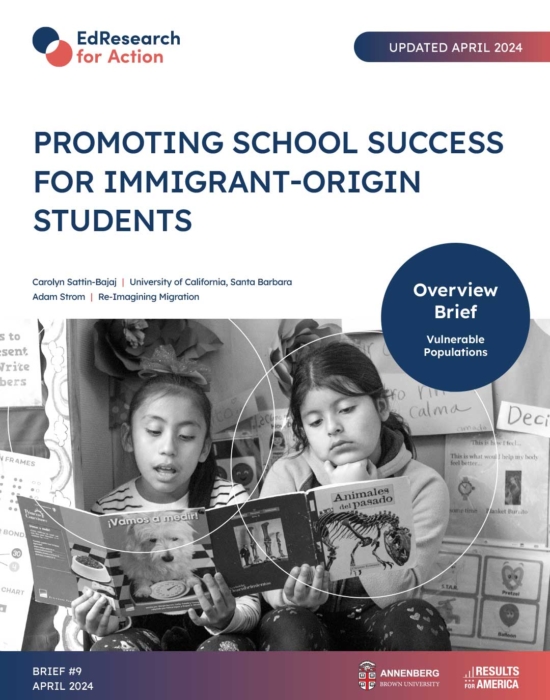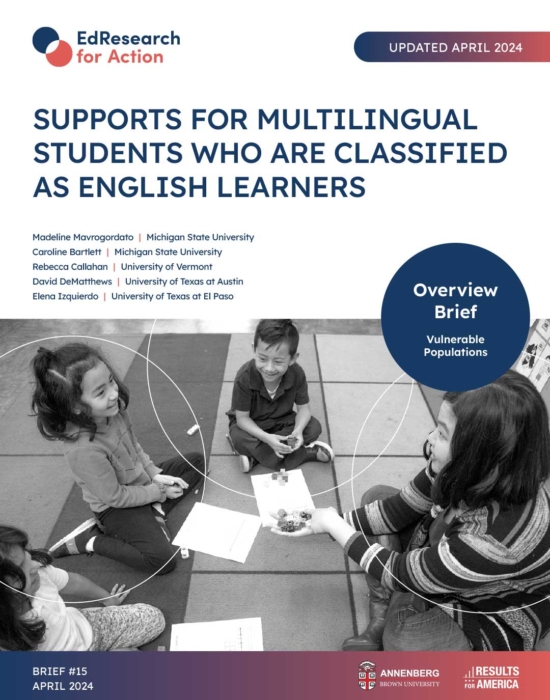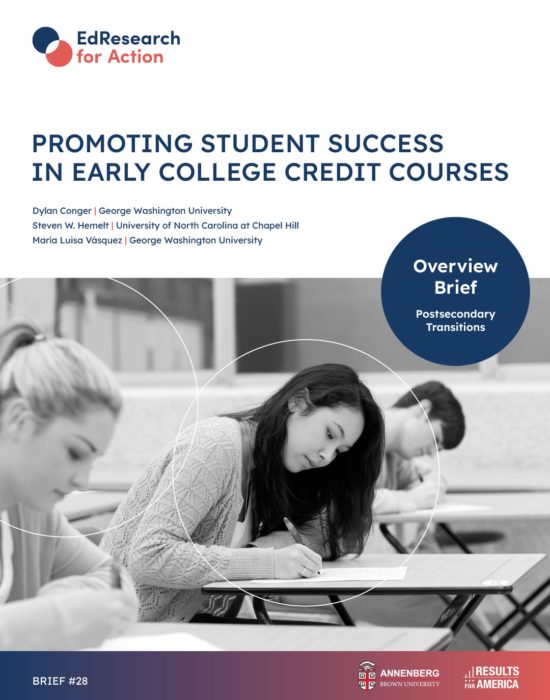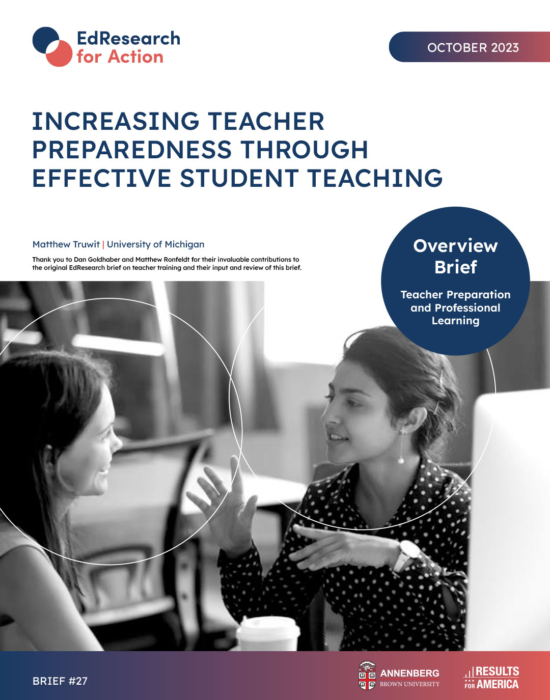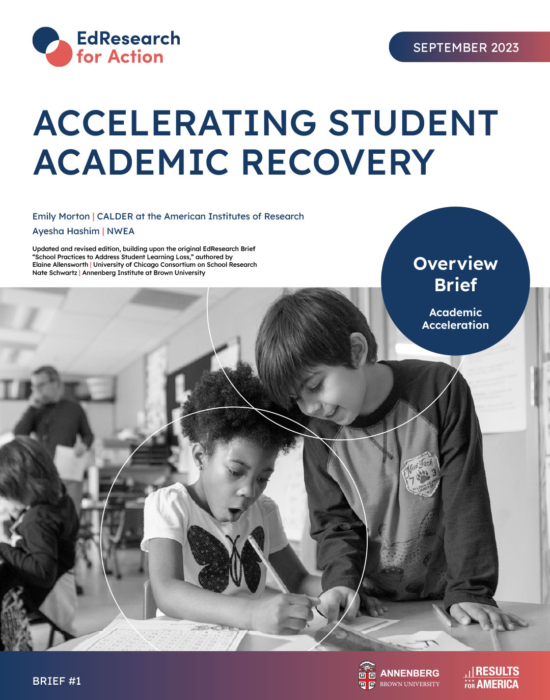SUPPORTS FOR STUDENTS WHO ARE ENGLISH LEARNERS
This brief is one in a series aimed at providing K-12 education decision makers and advocates with an evidence base to ground discussions about how to best serve students during and following the novel coronavirus pandemic.
Madeline Mavrogordato | Michigan State University
Rebecca Callahan | The University of Vermont
David DeMatthews | The University of Texas at Austin
Elena Izquierdo | The University of Texas, El Paso
February 2021 | Brief No. 15
Central Question
Recognizing longstanding educational inequities, what research-backed practices can district administrators, school leaders, and classroom teachers use to support English Learner (EL) students’ academic success and linguistic development in an instructional context transformed by COVID-19?
Key Insights
Breaking Down the Issue
- EL students are a rapidly growing and diverse population entitled to English language development instruction that will allow meaningful access to academic content.
- Complex federal laws govern the education of EL students and continue to hold state and local education agencies accountable for their academic performance even during the pandemic.
- School leader and teacher training rarely provides sufficient support for how to meet the unique needs of EL students.
Strategies to Consider
- Concrete steps to embrace the cultural and linguistic assets of EL students, families, and communities can lead to higher levels of trust and engagement among all stakeholders and improve students’ academic identity and achievement.
- Continuous professional learning, inquiry, and collaboration between EL and general education teachers can improve instruction for EL students.
- High-quality instructional resources designed specifically for EL students coupled with carefully-selected technologies can increase student achievement and language proficiency. Attendance monitoring systems coupled with targeted outreach efforts in students’ native language can help improve attendance for all students, but particularly ELs.
- Additional funding for EL students provided through Title III and the CARES Act can be invested in key strategies such as extended learning time and small group tutoring.
Strategies to Avoid
- Even prior to the financial strain caused by the pandemic, there have been concerns about districts diverting funding earmarked for EL students to other uses.
- Mere translation of content is insufficient to meet EL students’ needs.
Breaking Down the Issue
EL students are a rapidly growing and diverse population entitled to English language development instruction that will allow meaningful access to academic content.
- Roughly 5 million children, or 10% of public school students, are classified as ELs.
- EL students represent a broad range of cultures, languages, and backgrounds.
- Nearly 75% of ELs are Spanish speaking, though in total ELs speak more than 400 languages.
- While some ELs are immigrants, the majority were born in the United States; 85% of pre-kindergarten to 5th grade EL students and 62% of 6th to 12th grade EL students are U.S.-born.
- While EL students have historically been concentrated in traditional immigrant gateway states (e.g., CA, TX, NY) and large urban school districts, more recently the Latino/a diaspora has led to an increase in EL populations across the country.
- There are marked educational disparities between ELs and their peers.
- ELs fall behind their non-EL peers on standardized testing, are less likely to enroll in honors and advanced coursework, and are less likely to graduate high school.
- The digital divide is pronounced for EL students, who are less likely to have access to digital learning devices and internet connectivity.
Complex federal laws govern the education of EL students and continue to hold state and local education agencies accountable for their academic performance even during the pandemic.
- While temporary waivers for EL identification and assessment were granted during spring 2020, theU.S. Department of Education has indicated that states should not necessarily expect similar waivers as the pandemic continues.
- Despite obstacles that have arisen during the pandemic, state and local education agencies must continue to provide English language development services, academic supports, and appropriate accommodations to EL students.
- EL students must continue to be identified efficiently upon entering school.
- The annual review process to determine eligibility to exit EL status and be reclassified as English proficient is complicated by the challenges posed by administering English language proficiency assessments during the pandemic.
- Federal Title III funds to support EL students are earmarked to provide supplemental services rather than supplanting services that are paid for by other funding sources.
- All resources (curricular, personnel) paid for through federal EL funds are meant to supplement general student funding already allocated to the school and district to support every student, including those who are EL identified.
- During financially difficult times, districts may be tempted to redistribute EL funding more broadly; however, doing so is a violation of federal law and results in diminished resources for EL students.
- Given the specific and heightened needs of EL students during the pandemic, additional federal funding for ELs is needed for educators to meet student needs in virtual and hybrid learning formats.
- Supplemental ESL teachers and paraprofessionals paid with EL funds should continue to be dispatched to support the needs of EL students during the pandemic.
School leader and teacher training rarely provides sufficient support for how to meet the unique needs of EL students.
- Many principal and teacher preparation programs fail to provide instructional knowledge to understand and meet the needs of EL students.
- General education teachers often have limited in-service training on how to design and implement high-quality instruction for EL students, assess and monitor progress, co-teach and co-plan, and identify digital learning resources specifically designed for EL students.
- NCTQ’s 2014 Teacher Prep Review found that only 24% of teacher preparation programs included program literacy coursework that adequately addressed strategies to teach EL students.
- Educators face heightened challenges in providing EL student supports during the pandemic.
- Teachers are more likely to use general digital resources that are not specifically designed with EL students in mind.
- Educators of ELs report having less professional development on digital learning resources than general education teachers.
- While EL students benefit from ESL as well as primary language support, educators face challenges providing these supports remotely.
Strategies to Consider
Concrete steps to embrace the cultural and linguistic assets of EL students, families, and communities can lead to higher levels of trust and engagement among all stakeholders and improve students’ academic identity and achievement.
- Encouraging families to draw upon their native language can promote EL students’ academic success not only in their native language but in English as well since higher order language comprehension and literacy skills transfer from one language to another.
- A growing set of online learning resources is readily available to families in multiple languages.
- For Spanish-speaking families in particular, there are high-quality educational materials online including textbooks and videos to promote bilingualism.
- Family engagement programs that focus on bridging home literacy in students’ native languages have been found to hold promise for EL students.
- Consistent family-friendly communication, including text messages, with EL students and families in their home language may increase in-home support on assignments and improve family-school connections.
- California’s Pajaro Valley Unified School District implemented a particularly successful comprehensive communication strategy with families when the pandemic hit. Their approach included employing recent graduates who are trusted members of the community, parent engagement groups, tech support hotlines with multilingual technicians, website and social media outreach, testing outreach, and a question portal allowing direct communication with the superintendent.
Continuous professional learning, inquiry, and collaboration between EL and general education teachers can improve instruction for EL students.
- Research demonstrates the importance of creating opportunities for general educators and EL- focused educators to work collaboratively to improve teaching practices and promote equity for EL students.
- District and school leadership can establish norms around collaboration between ESL and general education teachers by allocating specific co-planning time and setting clear co-teaching expectations.
- Establishing a culture that encourages shared responsibility for EL students’ learning and positions every teacher as a language teacher can break down silos between general education and EL teachers.
- EL educators are benefitting from the opportunity to collaborate with their EL educator peers to build community and share ideas to expand capacity to best support EL students during the pandemic.
- Online professional development and virtual learning communities specifically aimed at supporting EL students can improve teacher and paraprofessional capacity for serving EL students.
High-quality instructional resources designed specifically for EL students coupled with carefully-selected technologies can increase student achievement and language proficiency.
- A recent study shows that ELs who attend schools that have instructional materials explicitly designed to develop English language proficiency outperform their peers who attend schools that do not invest in such curricular materials.
- High-quality lessons and learning resources aligned to state standards and designed to appropriately integrate language development and grade-level content learning can increase EL student performance.
- Translations, eBooks, intentional vocabulary development, and use of definitions and cognates can enhance language development and allow ELs to access grade-level lessons.
- Technology integration can provide valuable multimodal resources for ELs.
- Use of digital learning resources specifically designed for EL students allows ELs to practice and apply all language modalities (e.g., listening, speaking, reading, writing) across content areas, which can increase academic language proficiency and overall achievement.
- For example, Open Educational Resources (OER) can support EL teaching and learning.
- Schools that take steps to educate parents about the importance of attending school have been able to increase attendance for chronically absent students.
- The Attendance Matters Project conducted a randomized field experiment in 10 school districts examining the impact of an intervention that sent six distinct mailers emphasizing the connection between good attendance and specific grade-based learning outcomes to parents of high-absence students. The study found attendance increased by 15% across all students, and, notably, that the treatment effect was more than twice the size for EL students compared to native-English speaking students.
- The intervention took families’ native language into account and sent mailers in Spanish to students from Spanish-speaking families.
- The total cost of the intervention was $5.68 per student per year.
Additional funding for EL students provided through Title III and the CARES Act can be invested in key strategies such as extended learning time and small group tutoring.
- Extended learning time outside of regular school hours or during the summer is especially helpful to EL students.
- For example, Center City Public Charter Schools use Title III funds to operate ESL After the Bell, a two-hour after-school program designed to meet EL academic support needs. The program uses project-based and service-learning strategies aligned with both WIDA and Common Core State Standards to develop students’ content knowledge while acquiring English proficiency.
- After-school programs that focus on building connections like “reading buddies” can allow ELs of different ages to connect, build community, mentor and be mentored, and generally feel welcome at school. These programs are especially beneficial for newcomer ELs.
- Increasing opportunities to work one-on-one or in small groups with teachers, paraprofessionals or tutors in virtual settings can provide an additional boost for EL students.
- Small groups should be intentionally designed to include specific EL students with a common learning need. For example, one group of EL students may need assistance with foundational reading skills, whereas another group may have a strong literacy background in their native language and need to focus more on transferring those skills into English.
- Some states have recognized the heightened need for EL students to have face-to-face learning opportunities and have built policies that prioritize them for in-person instruction.
- In Michigan, high schools were required to transition to serving students totally online except for in-person instruction of EL students and students who require special education services. Districts should consider taking advantage of such exemptions to meet face-to-face with EL students safely in small groups.
Strategies to Avoid
Even prior to the financial strain caused by the pandemic, there have been concerns about districts diverting funding earmarked for EL students to other uses.
Public school leaders and educators will have to address financial shortfalls and a lack of resources overall. In setting budget priorities during the pandemic, it is critical to keep equity in mind to ensure the needs of EL students are met.
- Funding for EL students is sparse to begin with and many argue is insufficient to meet their needs for additional linguistic supports. Moreover, EL students are much more likely to attend under-resourced schools than their white, native-English speaking counterparts, compounding funding inequities.
- Once EL funding has been diverted to other uses during times of economic stress, it is unlikely to be returned to EL students after financial struggles have passed, further exacerbating existing inequities in educational access for the long term.
Mere translation of content is insufficient to meet EL students’ needs.
Researchers have shown that merely translating content alone is insufficient support for EL families; it is also important for educators to unpack and explain the norms of U.S. schooling for EL families.
- Educators must go beyond translation and utilize effective strategies to scaffold learning such as modeling and taking explicit steps to develop academic language in content-area classes to improve outcomes for ELs.
- Securing online resources designed to engage EL students in grade-level academic content can provide audio and visual support that goes beyond translation to build language and literacy skills.





Funding for this research was provided by the Bill & Melinda Gates Foundation. The findings and conclusions contained within are those of the authors and do not necessarily reflect positions or policies of the foundation.

